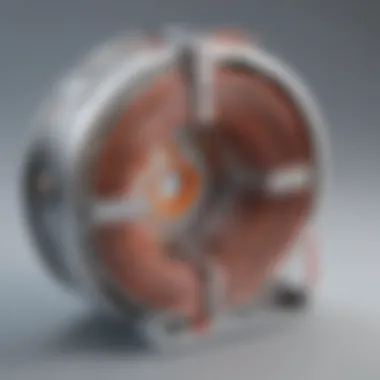Understanding the Creation of Electromagnets: A Deep Dive


Intro
Creating electromagnets is a fascinating subject that combines physics and practical applications. It requires an understanding of basic principles such as electricity and magnetism. This guide looks into how electromagnets are made, the materials used, and their everyday usage. Knowing about electromagnets helps us grasp many modern technologies we often take for granted.
Science Fun Facts
Electromagnets may seem basic, yet they hold several surprising facts:
- Electromagnetic Cranes: Large cranes use powerful electromagnets to lift heavy metal objects.
- Hidden Magnetism: You can turn an electromagnet on and off with electricity, unlike permanent magnets that always generate a magnetic field.
- Broad Usage: Electromagnets are used in credit card readers and MRI machines. These machines rely on magnetic fields to work correctly.
- Incredible Power: Some solenoid magnets produce fields strong enough to cause attraction with items; they can lift over a ton using electromagnetic force.
“Electromagnets are pivotal in advancing various fields from medicine to electrics.”
Discover the Wonders of Science
Many young learners or curious adults seek to understand how electromagnets function. Here are some ways to explore electromagnets effectively:
- Interactive Videos: Platforms like YouTube host many discovery-oriented content on electromagnetism.
- Scientific Concepts: Understanding related concepts such as electric current and magnetic fields helps connect the ideas. Identify how electricity flowing through a coil of wire creates magnetism.
- Real-Life Applications: Research prominent uses of electromagnets in industries. They are essential in gadgets we encounter daily, such as speakers and motors.
Science Experiment Showcase
Building a simple electromagnet can provide deep understanding, here is a basic guide:
Materials List:
- Iron nail (one-inch)
- Insulated copper wire (around 3 feet)
- Battery (D-cell is suitable)
Step-by-Step Instructions:
- Wrap the Wire: Coil the copper wire around the iron nail. Make sure to leave enough free wire at each end to connect it to the battery.
- Connect to Battery: Attach one end of the wire to the battery's positive terminal and the other end to the negative terminal. Ensure that wire ends touch the terminals.
- Test: Bring small paper clips or metal shaving close to the nail. If done correctly, the nail should attract them.
Safety Tips:
- Be cautious when using the battery and electrical wire.
- Do not let the wires touch for a long time to avoid overheating.
This simples experiment brings a hands-on approach to understanding electromagnetic principles.
By analyzing how to create electromagnets, we learn the grounding of many modern technologies. They serve as essential elements in countless applications, shaping our daily interactions with technology.
Preface to Electromagnets
Electromagnets play a pivotal role in a myriad of applications in ou practical daily lives. This section introduces the concept of electromagnets, outlining their fundamental significance and the functioning principles that make them pivotal in technology. Understanding this topic is essential for grasping not only how they operate but also how they power contemporary devices.
Defining Electromagnets
An electromagnet is a type of magnet where a magnetic field is created by an electric current. Unlike permanent magnets, electromagnets can be turned on and off. This unique characteristic stems from their essential components, which will be explored in further detail. When the current through the wire coils is cut off, the magnetic field disappears, making electromagnets highly versatile for various experiments and applications.
Importance of Electromagnets
Electromagnets are important for multiple reasons:
- Control: They allow for control over the magnetic field, facilitating the operation of devices such as cranes, which lift heavy materials.
- Technology: They are vital in numerous electronic devices like motors, speakers, and transformers.
- Safety and Reliability: The ability to deactivate an electromagnet when not in use enhances safety and prevents accidents compared to a permanent magnet.
Electromagnets' versatility drives innovations in engineering and technology. They adapt seamlessly across diverse fields, from industrial machinery to consumer electronics. Thus, understanding their creation and application is crucial for comprehending the broader landscape of technology today.
Basic Components of an Electromagnet
Electromagnets rely on specific components to function effectively. Each part plays a vital role in ensuring the desired magnetic properties are achieved. In this section, we will investigate the fundamental components, their significance, and considerations surrounding them. A strong understanding of these components paves the way for better applications in technology and daily life.
Wires


The wire used in an electromagnet is perhaps the most fundamental necessity. The conductivity and durability of the wire significantly affect the strength of the generated magnetic field. Typically, copper wire is favored due to its excellent electrical properties. However, there are other factors that one must consider.
- Conductivity: A high level of conductivity means that less energy is lost as heat.
- Gauge: The thickness of the wire can play a role; thinner wire may overheat while thicker wire can be cumbersome.
The choice of wire directly impacts performance, underscoring the need to select it carefully based on the measurement conditions and intended use.
Core Materials
Core materials serve to enhance the magnetic field produced by the coiled wire. They are essential for effective electromagnet design. Now, we detail the core materials employed most commonly in electromagnet construction: Soft Iron, Copper, and Other Magnetic Materials.
Soft Iron
Soft Iron displays a significant feature that distinguishes it in electromagnet construction: it possesses a high permeability which enables it to easily become magnetized. This characteristic helps achieve a stronger overall magnetic field. Furthermore, soft iron can demagnetize efficiently, returning to its original state once power is cut. As a result, it presents a dynamic solution in applications like relays.
Key Characteristics:
- High Permeability: Soft iron draws magnetic lines more effectively.
- Quick Demagnetization: Helpful in devices requiring on-off operation.
Copper
Copper may come into consideration concerning core materials. Though primarily recognized for its usage as wire, it can also support magnetism when need arises. Copper possesses high electrical conductivity but lacks magnetic properties when compared to traditional core materials.
Key Characteristics:
- Outstanding Conductivity: Vital for creating efficient electromagnets.
- Non-Magnetic: Not suited as core in typical applications but can conduct electricity effectively.
Other Magnetic Materials
Different materials aside from soft iron and copper can also enhance the electromagnet's efficiency. Ferrites and certain alloys are examples of other magnetic materials. They can offer specific advantages in distinct scenarios, huen there are considerations as well.
Key Characteristics:
- Diverse Properties: Vary depending on the particular material and intended use.
- Potential Advantage: Certain designs may optimize specific qualities like temperature stability.
Power Source
The power source stands out as the final necessary component of an electromagnet. It supplies the current that gives rise to the magnetic field. The choice of power, be it batteries or plugs, determines how effectively the electromagnet performs. Being cautious about voltage levels is important to prevent overheating or damaging the components within the setup.
In summary, understanding the basic components of an electromagnet aids in grasping how they function and where improvements can be made. With an informed approach, one can effectively harness the power of electromagnets in both everyday applications and complex projects.
The Process of Creating an Electromagnet
The process of creating an electromagnet involves not just assembly, but also deep knowledge of materials and electromagnetic principles. Understanding this process allows us to grasp the nature of electromagnets beyond simple descriptions. By selecting the right materials and following precise methods, one can build electromagnets that perform for various applications. It is essential to choose suitable wire, wind the coil correctly, insert the core properly, and connect the power source in phase. Each of these steps has specific implications on the electromagnet's strength and efficiency.
Choosing the Wire Type
Choosing the right wire type is fundamental to the successful creation of an electromagnet. Copper wire is often favored for its excellent conductivity. Thicker wires can carry more current, reducing energy loss due to resistance. However, using thicker wires increases weight. This can be disadvantageous in some designs.
Another option is aluminum wire. It is lighter and cheaper than copper, but has higher resistance. This leads to less efficiency when a high power source is unavailable. The tradeoff between weight and conductivity should be considered when selecting a wire type.
Winding the Coil
Winding the coil is critical for the electromagnet's function. The coil acts as the solenoid, which transforms the electric flow into magnetic fields. Proper winding ensures that magnetic alignment is consistent and efficient.
Coil Configuration
Coil configuration fundamentally influences how compactly and efficiently the magnetic field is aligned. A simple cylindrical configuration is popular. It generates a uniform magnetic field. Variations, such as toroidal coils, may also be used but require careful design. The key characteristic of a cylindrical configuration is ease of construction, making it a favorable choice in beginner projects.
The unique feature of coil configuration, especially the simple one, is its adaptability. It can be scaled and modified easily to meet different thermal and operational needs. Boca in, construction, is wider with lesser experimental variables.
Number of Turns


The number of turns in the coil directly affects the efficiency and strength of the electromagnet. More turns increase the strength of the magnetic field generated when electric current flows through the coil. This function is in direct competition with the wire length, excess, or efficiency.
A higher number also implies increased labor and complexity. Depending on the electromagnetic design's purpose, striking a balance between too many and too few from the starting wire kit will allow for functionalism or crafty ventures.
Inserting the Core
Inserting a suitable core is important for refining the magnetic field created by the coil. Commonly, soft iron is used due to its high permeability. It allows for quick magnetization and demagnetization. This feature is beneficial for applications requiring frequent switching.
The core should fit closely to maximize the magnetic flux produced. A loose core can lead to leaks in magnetic energy, affecting the performance. Inlet positioning as preservable orders and suggestions from deviation, however, bring variability in construction functions that would influence the ongoing process.
Connecting the Power Source
The final step is connecting the power source to the system. The connection must be secure to ensure that adequate current flows through the wire. Safety precautions, such as using adequate ammeters, help prevent potential overloads that could damage components.
Consider using a variable resistor to control the current. This option lets you modulate the strength of the electromagnetic field. Such control is useful in applications where precise adjustments are necessary.
With this thoughtful series of steps, the successful creation of an electromagnet reflects careful consideration of design, materials, and practices. Each component and method mapped out feeds into the final result, establishing powerful and effective tools for a variety of electro-motive functions.
Understanding Electromagnetic Principles
Understanding electromagnetic principles is crucial for anyone interested in creating and utilizing electromagnets. These principles not only underlie the formation and operation of electromagnets but also connect to many real-world applications. By grasping these concepts, one gains insights into how electrical energy converts to magnetic force. This knowledge can lead to innovations in various fields such as engineering, electronics, and physics.
The two primary principles discussed in this article are Ampere's Law and the Right-Hand Rule. Ampere's Law describes the relationship between current and the magnetic field it produces. It is essential for understanding how the electric current flowing through a wire influences the magnetic field around it. Consequently, this understanding is foundational for both design and function of electromagnets.
The Right-Hand Rule serves as a handy visual tool. It helps predict the direction of the magnetic field created by an electric current through a straight wire or the coils of a wire. Knowing these directional patterns aids in successful circuit configuration for electromagnets.
Grasping these fundamental electromagnetic principles can significantly impact engineering projects, efficiency of energy use, and the effective application of electromagnets in everyday devices.
"Mastering the fundamentals is the key to innovation."
Ampere's Law
Ampere's Law is a cornerstone of electromagnetic theory. It provides a mathematical description relating the strength of the magnetic field to the electric current driving it. In essence, this law states that the proportionality of the magnetic field around a current-carrying conductor is directly related to the amount of current flowing through it.
Mathematically, Ampere's Law can be expressed as:
Where:
- ( \oint_C \boldsymbolB \bullet d\boldsymboll ) represents the line integral of the magnetic field son the closed path C,
- (\mu_0) is the magnetic permeability constant, and
This law fundamentally expresses that u>increasing current leads to a stronger magnetic fieldu>. Understanding this principle is vital for various applications, be it in electric motors, generators, or even magnetic lifting systems. Several devices exploit this fundamental relationship to operate efficiently.
Right-Hand Rule
The Right-Hand Rule is a simple and effective method to determine the orientation of the magnetic field with respect to an electric current. To use this rule, follow these steps:
- Point your thumb in the direction of conventional current (the flow of positive charge).
- Curl your fingers around the wire. This shift represents the direction of the magnetic field lines around the wire.
This rule is not only applicable for straight wires but also for loops and coils of wire, where it is used to visualize the resulting magnetic field direction. For example, in a solenoid, the fingers represent the direction of the field lines, and your thumb indicates the direction of the magnetic north pole, which is critical for most electromagnet designs.
Understanding the Right-Hand Rule can enhance comprehension of locomotive systems, magnetic switches, or transformers. Keeping these principles in mind ensures both safety and efficacy when creating electromagnets.
Applications of Electromagnets
Electromagnets find their utility in a variety of fields, presenting both significant advantages and specific considerations. They are critical in industries and everyday life. Their versatility makes them essential in both basic and complex mechanisms. Understanding various applications helps establish their functional relevance in technology.
Industrial Applications
Motors


In motors, electromagnets are crucial as they facilitate mechanical energy conversion. The key characteristic of these motors lies in their effectiveness in energy conversion, allowing for diverse operational uses. Moreover, they are reliable, consistent, and capable of maintaining performance over long periods.
A unique feature of motors is their ability to control speed and direction effortlessly. This capability is advantageous in many applications, ranging from household appliances to industrial machines. However, high power consumption and heat generation can be considerable downsides when managing their operation.
Generators
Electromagnets also play a significant role in generators, transforming mechanical energy into electrical energy. The primary attribute of dynamic generators stems from their efficiency in energy production. Such generators are also popular due to their ability to generate power over a broad usage range.
A distinctive element of generators is their reliance on constant motion. This dependency can be an advantage, allowing for sustained energy output. On the flip side, situations lacking motion can interrupt energy generation, making pace maintenance crucial to operational reliability.
Consumer Electronics
In consumer electronics, electromagnets enable various applications, including speakers and headsets. They enhance sound amplification through the vibrational effect in speaker design. Electromagnets help achieve clarity and quality sound output. Their integration into common devices makes them invaluable, providing enhanced audio experiences.
Magnetic Levitation
Magnetic levitation takes advantage of electromagnets for transportation systems, particularly in trains. This technology employs repulsive force to eliminate surface friction, allowing smooth and efficient travel. It signifies faster transit with lower energy costs compared to conventional systems. However, the implementation requires significant upfront investments.
The adaptability of electromagnets showcases their fundamental importance across numerous sectors, especially in manufacturing and technology.
Overall, understanding these applications highlights how electromagnets enhance efficiency and innovation in various fields, ultimately advancing our daily experiences.
Safety Considerations
Safety is paramount when working with electromagnets. Understanding how to handle their components and the electric current that powers them is vital to avoid accidents and injuries. Being aware of the potential risks is not just about safety but also about ensuring the effectiveness of the electromagnet itself. This section outlines key safety practices that should be prioritized during the creation and use of electromagnets, which will contribute to a smoother and safer process.
Avoiding Overheating
Electromagnets generate heat when electricity flows through the winding wires. If the heat is not managed appropriately, it can lead to overheating. Overheating can damage the insulation around the wire, potentially causing shorts and even fires. Here are precautionary measures to minimize the risk of overheating:
- Monitor Your Current: Use an ammeter to track how much current is running through the coil. Exceeding the suitable current for the wire type can cause significant heat generation.
- Choose Suitable Wire: Select wire with a higher temperature rating. Enamel-coated copper wire is often a good choice as it offers better heat resistance compared to others.
- Implement Cooling Techniques: If the design allows, consider the use of cooling fans or heat sinks. Even establishing intervals of use can help control the temperature and mitigate heating issues.
- Routine Checks: It's essential to regularly check the temperature of the coil while it's operational. If you notice excessive heat, disconnect the power immediately and allow it to cool.
Following these steps can drastically reduce the possibility of overheating, allowing for safe and reliable performance during use.
Handling Electricity Safely
Electricity has inherent dangers, and its role in powering electromagnets amplifies the need for safe handling procedures. Here are critical strategies for ensuring safety when dealing with electrical components:
- Disconnect Power When Modifying: Always ensure that the power is off when making alterations to the wiring or connections. This prevents accidental electric shocks.
- Use Insulated Tools: Employ tools designed to handle electricity safely. Insulated handles offer an extra layer of protection against accidental contact with live wires.
- Understand Circuit Limitations: Familiarize yourself with the specifications of the power source and components. Overloading the circuit can lead to failures or hazards.
- Ground Connections: Proper grounding is essential, reducing the risk of electric shock and circuit damage. Ensure that your setup is equipped with appropriate grounding systems.
Proper knowledge and practices can significantly mitigate the dangers associated with electricity. Prioritize safety to ensure a successful project with electromagnets.
These considerations are crucial not only for personal safety but also for maximizing the efficiency and functionality of electromagnets.
Future of Electromagnet Technology
The study of electromagnet technology is progressively evolving. As we move toward a more technologically integrated world, understanding the potential future of electromagnet technology becomes quite crucial. The relevance of this topic lies in its application across various sectors, from industry to healthcare. Innovations in electromagnets promise not only enhanced efficiency but also new functionalities that can affect daily life. Topics such as miniaturization and improved energy consumption are key areas which make it necessary to stay informed about these advancements.
Innovative Research
Research in the domain of electromagnets is ongoing and multifaceted. One significant trend is the pursuit of stronger and more efficient electromagnets. This drives developments in materials science, electronics, and energy. Researchers are experimenting with unique materials like superconductors. These materials can possibly lead to a good reduction in energy loss, thus making electromagnets more efficient.
- Applications in industry could benefit immensely. Stronger electromagnets can lead to more compact machinery while improving performance.
- Moreover, wrapping techniques and coatings are enhanced for better conductivity and resistance to wear, making electromagnets more potent in changing conditions.
- Academia and industry partnerships are instrumental in cutting-edge research, leading to technologies that extend the practical utility of electromagnets.
The implications of innovative research in electromagnet technology extend better work and also spawn entirely new industries, thus creating more jobs and opportunities.
Sustainable Practices
Sustainability is an increasingly critical factor in all technological advancements, including electromagnets. The future of this technology strongly requires practices that are environmentally friendly.
- Utilizing renewable energy sources for power supply can help minimize the ecological footprint.
- Research is also being directed toward developing sustainable materials that would refine creation methods. If core materials are recyclable, it could immensely support sustainability goals.
- Another area of focus is the lifecycle of electromagnetic devices, with longer-lasting components reducing waste over time.
By embedding sustainable practices into electromagnet technology, the negative impact on the environment could be largely lowered while still meeting the demands of our advanced society. Such a balanced approach supports the eco-system, but it might also prepare a path for innovations in energy efficiency and effectiveness.
Efficient and sustainable electromagnet technology could shape the future of air transportation, renewable energy applications, and medical equipment.
Moving forward, a blend of innovative research and sustainable practices may create favorable conditions not only for optimal functionality of electromagnets but also for a future where technology supports both human needs and environmental integrity.







